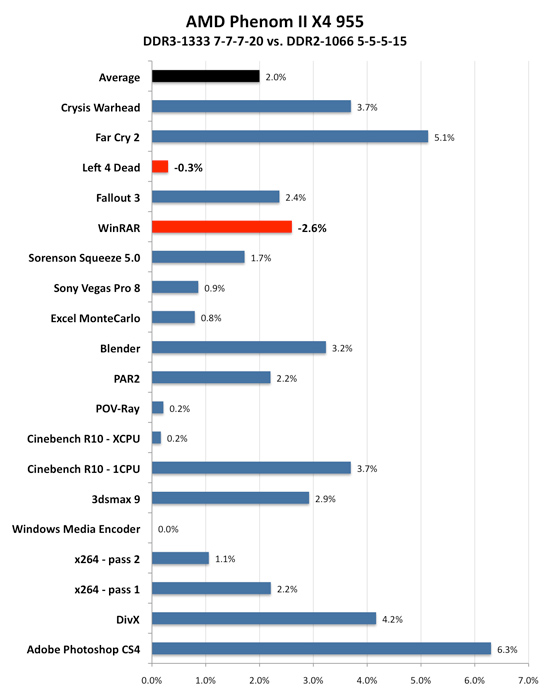AMD's Phenom II X4 955 Black Edition
by Anand Lal Shimpi on April 23, 2009 12:00 AM EST- Posted in
- CPUs
The Move to DDR3: You Can Do It
The Phenom II 955 and 945 support both DDR3 and DDR2 memory. Just a couple of months ago you could save a good amount of money by going with DDR2 over DDR3, but these days the price difference is negligible.
A good pair of 2GB DDR2-1066 sticks will set you back around $57 while a pair of 2GB DDR3-1333 modules will sell for around $60. The problem is that faster DDR3 modules usually have higher latencies associated with them. The table below shows the CAS latency of these modules in ns:
| Memory | DDR2-800 | DDR2-1066 | DDR3-1066 | DDR3-1333 | DDR3-1600 |
| Data Rate | 800MHz | 1066MHz | 1066MHz | 1333MHz | 1600MHz |
| CAS Latency | 4 | 5 | 5 | 7 | 9 |
| CAS Latency in ns | 5 ns | 4.69 ns | 4.69 ns | 5.25 ns | 5.63 ns |
From a latency perspective, DDR2 or DDR3-1066 at CL5 is your best bet. However there is a benefit from having more bandwidth; DDR3-1333 delivers 25% more bandwidth but typical DDR3-1333 modules run at CL7 which translates into 12% higher CAS latency than CL5 at 1066.
The chart below shows the performance improvement from running DDR3-1333 (7-7-7-20) vs. DDR2-1066 (5-5-5-15) on the Phenom II X4 955:

In all but two cases the improved bandwidth, but higher latency DDR3-1333 was faster - but the average performance improvement was only 2%. Some applications managed to see a 5 - 6% increase in performance but overall don’t sweat the difference.
Obviously DDR3 is going to do you more good in the long run so it’s what I’d recommend you stick to if you are building a new system. It’s lasted us a long time and we’ve enjoyed its extreme affordability, but DDR2 is finally on its way out.










65 Comments
View All Comments
Procurion - Thursday, April 23, 2009 - link
Cool. My next question would be to wonder why it didn't kick in for the other tests? I guess it wasn't enabled for them? Looks good overall.JarredWalton - Thursday, April 23, 2009 - link
See page 4 - Turbo mode tends to activate pretty much any time a load is on the CPU. But it's not really "unfair" as all i7 users get that benefit without doing anything extra, plus i7 chips still overclock far beyond that point.ChemicalAffinity - Thursday, April 23, 2009 - link
Best post ever.whatthehey - Thursday, April 23, 2009 - link
Congratulations on the cryptic post... or is that pointless post? I'm guessing you're suggesting that the words listed were used with two different companies - AMD and Intel - but if so they certainly weren't used in this article in any way I can see. Care to enlighten the rest of us on the point of your comment?Some people are too clever for their own good; others merely think they're clever. Guess which one you are.
Lokinhow - Thursday, April 23, 2009 - link
Oh man, I thinking about the OC3.9GHz on Vista x64
4.2GHz on Vista x86
Why it happens?
Does the results are the same using XP x86/x64 and Windows 7 x86/x64?
That would be interesting to see if it is possible to reach 4.2GHz on Windows 7 x64
Griswold - Thursday, April 23, 2009 - link
Dont hold your breath. Theres more registers (etc) in use under a 64bit OS than a 32bit one. Its highly unlikely that there will be any difference on the exact same hardware. And even if there is a difference between xp/vista/7, 32bit 7 will outdo 64bit 7 as well. 64bit was never the ideal choice for overclocking records...Spoelie - Thursday, April 23, 2009 - link
In the CS4 test, given the large increase in performance when just going from DDR2 to DDR3, would a faster NB clock (2->2.6/2.8ghz) and faster than DDR1333 memory, while keeping the core at default clock, level the playing field with the core2 processors?Seems that in this particular test the phenom is starved for data.
duploxxx - Thursday, April 23, 2009 - link
why do you use these 1GB dimm's in ddr3 config? I would assume you have more oc issues with 4 dimms in stead off 2 dimms?G.Skill DDR2-800 2 x 2GB (4-4-4-12)
G.Skill DDR2-1066 2 x 2GB (5-5-5-15)
Qimonda DDR3-1066 4 x 1GB (7-7-7-20)
Corsair DDR3-1333 4 x 1GB (7-7-7-20)
Holly - Thursday, April 23, 2009 - link
Nice article :-)btw... last paragraph on the first page... "faster than the Core 2 Duo Q9550." should say "faster than the Core 2 Quad Q9550."
ibm386 - Sunday, June 27, 2010 - link
Intel and Amd are owned by the same person. Since a person can't have monoply in U.S. It has been divided into two different names and obviously diff. CEOs.cheers.